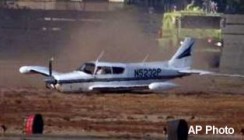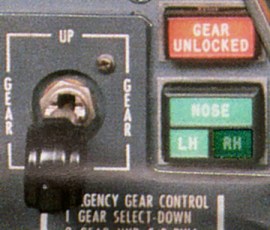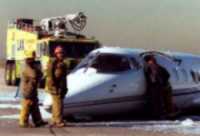One of my early claims involved a pilot who was flying his recently purchased Beech Bonanza and could not get the landing gear to extend. He conscientiously tried everything he could think of to extend the gear, but finally resigned himself to the fact that he was going to have to make a gear-up landing. He methodically burned off as much fuel as possible, asked for the emergency equipment to stand-by and made as smooth a touch down as possible with the wheels retracted. All in all a successful outcome except for the belly and prop damage. Shortly after the incident the pilot was interviewed by the FAA who asked the pilot if he was able to rotate the emergency extension hand crank located behind the pilot’s seat to extend the gear. The pilot replied “What hand crank?”
It’s hard to know whether to laugh or cry when you hear a story like this, but it is really only a variation on a continuing theme of pilots causing great bodily harm to their retractable gear aircraft. Yes we have all heard the expression there are “those who have and those who will” when it comes to the predictability of a gear up event. I personally don’t share this philosophy. There are plenty of RG pilots out there who will roll steadily back to their tie down through out their flying career. So what about those that don’t?
 When a gear-up landing is reported to my office I try to tread lightly when I interview the pilot. I know that he has already sustained an ego bruising. Most pilots are up front and honest about what happened. Some assert that a mechanical failure is the responsible culprit. A good investigation will disclose the truth and while mechanical problems occasionally contribute to a gear collapse or extension failure, most problems are, well, let me put it this way: “We have met the enemy and he is us.”
When a gear-up landing is reported to my office I try to tread lightly when I interview the pilot. I know that he has already sustained an ego bruising. Most pilots are up front and honest about what happened. Some assert that a mechanical failure is the responsible culprit. A good investigation will disclose the truth and while mechanical problems occasionally contribute to a gear collapse or extension failure, most problems are, well, let me put it this way: “We have met the enemy and he is us.”
Inexperienced pilots transitioning to retractable gear aircraft have their own set of problems in adapting to faster and more complex aircraft, but remembering to raise and lower the gear is not one of them. It is the more experienced and complacent aviators among us who are the most likely to join the “those who have” club. I have handled gear-up claims involving pilots with over 20,000 hours and a wallet full of flying credentials. The average gear-upper I deal with has about 1500 hours or more total time and about 500 hours RG time. The incidents occur in all variety of aircraft from light single engine planes to heavy jets.
Even with gear warning horns, pilots can find new and creative ways to turn their planes into leg-less birds. Anyone who relies on a gear warning horn to save them, probably believes in the tooth fairy as well. The rigging of the gear warning horn seems to be universally set to go off at a power setting somewhere between engine idle and shutdown. Not very helpful for most of us carrying power on final. I did have one pilot of a gear-up landing report to me that his gear horn went off prior to touchdown. Unfortunately, at the time he thought it was the stall warning horn so he ignored it. In another instance an instructor giving instruction in a twin engine aircraft pulled the power back on one engine to simulate a single engine workload. With the throttle pulled back, the gear warning horn kept blaring so he pulled the gear system circuit breaker to silence it which also disables the gear motor. Want to guess the results?
 Automatic landing extension systems, such as on a Piper Arrow work great except for those unfortunates who come in faster than the gear activation speed or forgot that they had switched to the over-ride mode. Also, it is very hard to develop any kind of consistent habit pattern when sometimes you lower the gear manually and sometimes you let “Otto” do it. In any airplane your job doesn’t end just because you place the gear switch in the “down” position. You have to verify that the swing cycle is complete and that all three gear are locked into position. I have had claims where a pilot moved the lever or switch to “down” not realizing that the gear circuit breaker popped or the motor jammed only to have the partially extended gear collapse on landing. Also, be alert that sometimes things get out of rig and a gear motor may not shut off. The result can be a burned out gear motor and possible fire hazard from an overheated motor. My rule is to keep your hand on the gear control until the up or down cycle is complete and do not move your hand until you have verified gear extension or retraction from all means available which includes: lights and/or mechanical indicators, visual confirmation if you can see them, the sounds of the gear locking into place, and the sound of the gear motor shutting off.
Automatic landing extension systems, such as on a Piper Arrow work great except for those unfortunates who come in faster than the gear activation speed or forgot that they had switched to the over-ride mode. Also, it is very hard to develop any kind of consistent habit pattern when sometimes you lower the gear manually and sometimes you let “Otto” do it. In any airplane your job doesn’t end just because you place the gear switch in the “down” position. You have to verify that the swing cycle is complete and that all three gear are locked into position. I have had claims where a pilot moved the lever or switch to “down” not realizing that the gear circuit breaker popped or the motor jammed only to have the partially extended gear collapse on landing. Also, be alert that sometimes things get out of rig and a gear motor may not shut off. The result can be a burned out gear motor and possible fire hazard from an overheated motor. My rule is to keep your hand on the gear control until the up or down cycle is complete and do not move your hand until you have verified gear extension or retraction from all means available which includes: lights and/or mechanical indicators, visual confirmation if you can see them, the sounds of the gear locking into place, and the sound of the gear motor shutting off.
Another variety of gear-up accidents involves planes that make a normal landing only to have the gear fold during the roll-out because the pilot reached for the wrong lever at the wrong time. This was a common occurrence among pilots who switched between flying older retractable Beechcraft planes which had the non-standard placement of the gear switch on the right side and the flap switch to the left and then flying other planes with the opposite configuration. Out of habit they go to retract the flaps only to find that the gear switch is now occupying that particular piece of panel real estate and go for a slide on the pavement. This type of event happens even for those who fly the same plane on a regular basis. The moral of the story is don’t touch anything without verifying what it is and preferably not until you are off the active runway at a complete stop. When you touch a switch it may help to remember that a gear switch is round to represent a wheel and a flap switch often is shaped in flap-like form.
 The gear can also retract before you even get airborne. I had a claim where a passenger’s knee accidentally bumped a gear handle that had a weak detent causing the wheels to fold. What’s that you say? What about the squat switch to prevent ground retractions? You might as well put it under your pillow along with the gear warning horn while waiting for the tooth fairy to come along. They just don’t work. Either they are out of rig to begin with or the gear will fold as soon as wheel weight is unloaded during taxi or take-off. Speaking of take-off, always establish a positive rate-of-climb before retracting the gear especially in density altitude situations. I have handled a number of claims where the plane never really got out of ground effect and settled down on its belly because the landing gear was retracted prematurely. A prop hitting the pavement at take-off power is an ugly sight to behold.
The gear can also retract before you even get airborne. I had a claim where a passenger’s knee accidentally bumped a gear handle that had a weak detent causing the wheels to fold. What’s that you say? What about the squat switch to prevent ground retractions? You might as well put it under your pillow along with the gear warning horn while waiting for the tooth fairy to come along. They just don’t work. Either they are out of rig to begin with or the gear will fold as soon as wheel weight is unloaded during taxi or take-off. Speaking of take-off, always establish a positive rate-of-climb before retracting the gear especially in density altitude situations. I have handled a number of claims where the plane never really got out of ground effect and settled down on its belly because the landing gear was retracted prematurely. A prop hitting the pavement at take-off power is an ugly sight to behold.
Making the wheels of an aircraft go up or down is as simple as flipping a light switch. You can train any non-aviator to do it with a few minutes of instruction, but to do it right and accident-free over a lifetime of aviating requires establishing consistent and methodical habit patterns. It starts with a comprehensive knowledge of the landing gear system of the plane you fly including the appropriate V speeds and emergency or abnormal procedures. Gear extension and verification should be done as part of the pre-landing check list while outside the airport traffic area. A GUMP check (gas, undercarriage, mixture, prop/ pumps/ pressurization) works well for many. Double check gear extension on the first pattern leg while you complete the landing checklist. A final check should be done at 500 feet AGL on final and say out loud every time, “Gear down and verified!” which will serve as a habit pattern reinforcement on both a conscious and sub-conscious level. Once on the ground, avoid touching switches or retracting flaps during the roll out. If the flaps must be retracted, make sure it feels like a flap lever before moving it.
If anything unusual occurs prior to landing such as unexpected traffic, mechanical glitches, non-standard instructions from ATC, unscheduled go-arounds, and so forth, you have entered a “distraction mode.” Your habit patterns have been disrupted and you are vulnerable to forgetting tasks which are normally accomplished as part of your routine. After giving the distraction the requisite attention, get back to flying the plane with the recognition that you were distracted and do the check list dance one more time. It may save you from having to walk back to the tie-down.
Editor’s Note: This article was written by Ken Steiner prior to his retirement from the United States Aircraft Insurance Group as a Vice-President and Claims Manager. During his career, Ken investigated thousands of aircraft accidents involving small planes, crop dusters, helicopters, corporate aircraft, and airliners. He has been on-site at over 100 fatal aircraft accident investigations. He is currently an Aviation Investigative Consultant and is also a Pilot and Tactical Flight Officer for the San Mateo County Sheriff’s Air Support Unit. He owns a Cessna 182 based at San Carlos and holds ATP and CFI certificates with over 5000 flying hours.



